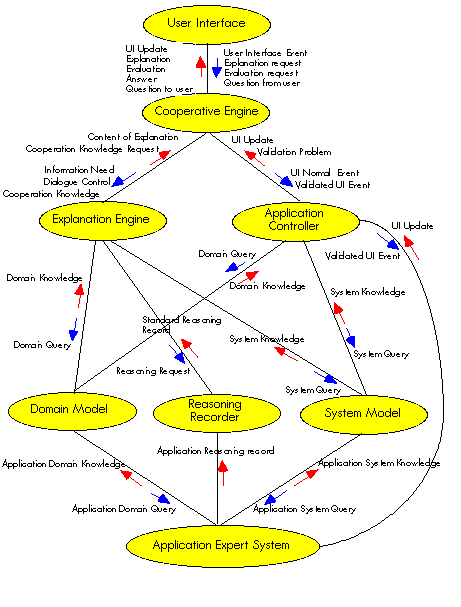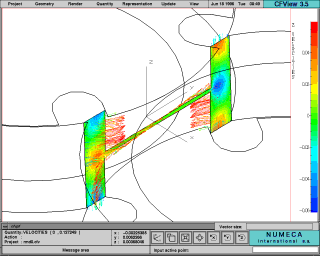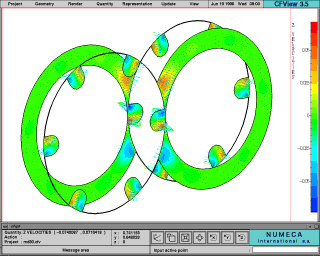


NOTE: many of the urls referenced in this newsletter are no longer active.
Interactive Self-Explaining Engine (I-SEE) was an ESPRIT III project, partly funded by the European Commission, which came to a successful conclusion in February 1996. CLRC was one of the partners in this collaborative project, which developed methods and a toolkit for enhancing software systems with co-operative, explanatory capabilities. These capabilities include explanations of the system's results and reasoning, intelligent help, and tailoring the output to fit in with both the user's capability and the task being performed.
The project was judged as having very high exploitation potential by the review team, and was selected for inclusion in the CEC's publication 101 Success Stories from ESPRIT.
The I-SEE project developed three application demonstrators. One is an expert system (GEANT) for monitoring and diagnosis of problems on sewage plants, and was developed with the French company Lyonnaise des Eaux. Another is a complex program for modelling oil spills at sea, developed by British Maritime Technology - showing that the usability of even conventional 'dusty deck' programs can be enhanced. The third application, from the French company Syseca, is a project management tool where there was a strong need for intelligent help facilities. As well as the three applications, one of the important end-products of the I-SEE project is the toolkit with which cooperative, explanatory capabilities can be added to further systems. These systems may already exist and be in use -this ability to 'retro-fit' explanatory facilities to pre-existing software is an important advantage of the I-SEE approach. The toolkit includes repertories of 'explanation techniques' and partial domain and system models, which are used to represent the underlying knowledge needed to generate effective explanations.

The illustration shows the object-based architecture of I-SEE linked to the GEANT expert system.
For more information see: http://www.cis.rl.ac.uk/proj/isee.html or contact Dr Gordon Ringland.
Enhancing competitive advantage is a goal of many organisations today. One road towards this goal includes finding effective and efficient means for improving business processes and procedures. The importance of these processes, eg handling a customer complaint, sending out an invoice, to an organisation's success is now widely known. Typically processes span departments requiring time consuming transfers and have no single person in charge. Providing support for the running of these processes can ensure work is completed on time, in the required manner and by making best use of available resources.

A fully integrated business case processing system has been developed in an ESPRIT III project called HICOS. The system covers the whole process life-cycle including analysis, design, specification and enactment by way of a suite of integrated tools and methodologies. The User Interface Design Group at CLRC, Rutherford Appleton Laboratory (RAL) was a technical partner in the HICOS project.
The initial phases of the life-cycle are concerned with the overall business view, identifying business objectives and rules and identifying and selecting existing processes. This is supported by a methodology, including an innovative handbook to guide the user.
The next phases concentrate on the selected process and include further investigation and evaluation of options for change/optimisation. This includes links to the organisation model and identifying existing application software. The methodology is supported by software that captures the wide variety of information about the chosen process and allows a graphical representation to be created.

This high-level design of the process now needs to be realised. The same graphical tool supports this necessary detailing which includes interfacing to existing applications, using external events and ensuring tasks are carried out by the correct person. Also provided are support modules to "build confidence" in the process design, including checking for syntactical correctness, reasoning about semantic correctness and simulation to confirm operational viability. Once the design is ready for trial it is automatically generated in the required form.
The final phases of the process life-cycle include the trials in a restricted environment and finally the full production environment. Software tools support the installation of the process design and the actual enactment. Monitoring and managing functions are also supported.
HICOS allows for gradual introduction into an organisation with as much or as little of the process supported at first. This is subsequently increased as existing applications are brought into HICOS and new applications become available.
HICOS is being actively marketed, currently in the German market but now expanding into production engineering as part of an ESPRIT IV Business Best Practice Pilot called WeDoIT (Workshops retain work for Disabled People by Introducing Process Technology). The User Interface Design Group at RAL is a technical partner in the WeDoIT project
WeDoIT is continuing development of HICOS and installing it into two sheltered workshops as a way of improving their effectiveness and efficiency and hence assisting them in capturing more business as well as improving their co-operation and sharing opportunities.

Sheltered workshops do not have the option to move their workforce nor to automate their production lines but need to become more competitive, both in terms of price and quality, in order to compete with cheaper labour markets. They also need to penetrate new markets and keep existing customers. WAAK, the sheltered workshop in Belgium, employs 1200 people with disabilities, and specialises in cable harnesses. They have already ISO 9002 certification. Lebenshilfe, the sheltered workshop in Germany, employs 300 people with mental disabilities, is currently preparing for ISO 9000, and specialises in sheet metal working.
Process technology is seen as a way of reducing costs in operation terms and time in process terms by optimising existing processes and increasing efficiency and by designing and implementing new processes. HICOS enhances the clarity and visibility of an organisation's processes and assists the organisation in responding rapidly to a changing business environment.
Introduction of HICOS into these workshops has allowed the evaluation and improvement of training materials, the methodologies and tools and their introduction to an end user.

The workshops are useful reference sites for the HICOS technology, demonstrating the potential of HTCOS in effectively supporting business processes.
For more information on HICOS see: http://www.cis.rl.ac.uk/proj/HICOS.html
The Polymer Processing and Performance Group at Aston University have used the finite element Computational Fluid Dynamics (CFD) program POLYFLOW on the Cray J90 (J90) at Rutherford Appleton Laboratory, CLRC to simulate the flow of viscous fluid within the various mixing zones of a closely intermeshing, co-rotating twin-screw extruder (co-TSE). Knowledge and understanding of the mixing characteristics exhibited by each of the different types of co-TSE mixing zones are required in order that ideal configurations for optimum mixing and shear levels may be achieved. One such zone is the staggered mixing discs section, which imposes predominantly extensive mixing mechanisms on the polymeric melt.

The J90 simulations describing the mixing discs section were performed on 3D unstructured meshes representing the exact dimensions for a pair of 40mm discs, including the small clearance between each disc. One of the objectives of this work, was to identify the different mixing mechanisms exhibited by both the in-line and off-line aperture arrangements and thus to establish whether the different disc configurations have any marked effect on the mixing levels achieved.

Post processing operations are performed on a Silicon Graphics Indy workstation and the flow fields generated are characterised in terms of velocity vectors, shear stresses and a parameter called the mixing efficiency which quantifies both the elongational and rotational flow components. Comparisons between the CFD simulations and observations obtained from a mechanical model, based upon the Betol BTS40 co-TSE and encased by a transparent outer barrel, have proved encouraging. Future work utilising the J90 will involve mixing disc simulations with meshes in the off-line aperture configuration.
For more information on this project see: http://ceac.aston.ac.uk/ under Recent Research Articles
Video conferencing is now becoming an accepted, even an expected, method of communication in the academic and commercial worlds. Accountants like it as it is generally cheaper than travelling; many people appreciate that it is a lot safer than travelling; and the people getting together gain all the time that is saved through not having to travel.
Rutherford Appleton Laboratory, CLRC (RAL) and Daresbury Laboratory, CLRC (DL) started using video conferencing in August 1994 and the growth in its use has been astounding. At RAL there is, on average, more than one video conference per day, with sometimes as many as four in a single day. There have been video conferences to every continent, at all times of the day, and some with many hundreds of participants.
RAL and DL both have centralised equipment with fibre optic links to a number of rooms equipped (permanently or on demand) for video conferences. As a result, any equipped room can be used on the Superjanet network, on ISDN, or (in the future) on the Mbone. In addition, these networks can be - and have been - interconnected, allowing users on ISDN to join Superjanet network events, and vice versa.
CLRC is now also looking at desktop video conferencing, in which a large number of proprietary, non-inter-working systems have vied for market domination. A small number of these are now showing signs of maturity and will be investigated for both intra-site and inter-site use.
Video conferencing is not intended as a substitute for meeting people, but many regularly held meetings are now adopting a pattern of perhaps three video conferences and one face-to-face meeting. Being back at your own institution is often invaluable when you realise you left a vital piece of paper behind!
For more information describing the video conferencing facilities, the networks and hints on booking and using the video conferencing systems at RAL see: http://www.cis.rl.ac.uk/services/VCF/
The Department for Computation and Information (DCI) is now able to offer its customers a Seminar on Demand service. This service is analogous to the proposed and much talked about Video on Demand services where videos are stored on a central server for distribution over a network directly into people's homes. In the case of DCI it is seminars, training courses etc that are stored rather than videos. Seminars are recorded and video clips, full audio and text of transparencies are stored in multi media format on a central server for later distribution either over World Wide Web (WWW) or by CD-ROM. The video clips are kept short in length. For most seminars it is usually sufficient to capture the full audio record of the event and to play the audio back in synchronisation with the associated transparencies. The amount of data required to be stored and transmitted over the network is considerably smaller than that required for a full video recording and the WWW becomes a viable and attractive communication medium.
DCI has recorded a lecture by Prof John Reid entitled The Current Status of Fortran 90 and Fortran 95 as a prototype and this is available on CD-ROM and on WWW.
The service is available to both internal and external customers of CLRC. If you are interested and would like more information, please contact the Marketing Manager, Dr Tim Pett (T.G.Pett@rl.ac.uk).
This highly successful annual event is organised to assist UK researchers with the purchasing of scientific computing equipment and is comprised of the following events:
Many systems will be accessible from your institute for up to two weeks prior to the workshop affording plenty of dedicated time for benchmarking your own codes.
The workshop is open to everybody from the UK research community, both from academia and industry. In addition, for recipients of related EPSRC scientific computing equipment grants, some assistance for travel and accommodation expenses may be available, contact Royd Whittington (details below) for information.
http://www.dl.ac.uk/TCS/DisCo/Events/workshop or contact Royd Whittington or Tristan Green.
We will be holding a three day parallel programming course at The Cosener's House Abingdon on 21 - 23 October 1996 targeted at Fortran programmers using the Atlas Cray J932. The course is intended to help accelerate the use of parallel techniques given the much larger number of CPUs on this machine compared with its predecessor.
The course is free to academic staff and students who are associated with a research grant on the Cray J932 or the DEC 8400 (Columbus).
If you would like to attend the course of register for further details then please contact: Roger Evans.